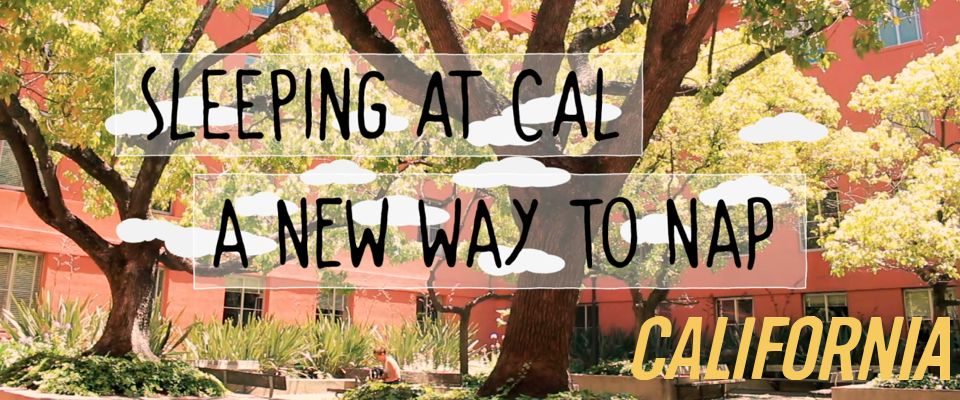When Melissa Hsu and Sarah Barett were students at UC Berkeley, the university launched a campaign advertising late-night study spaces with the tagline “sleep is for the weak.” For Melissa and Sarah, two typically overworked and under-rested students, the slogan rankled. They made it their mission to provide students not only with places to work but also with places to sleep. And so the Relaxation, Enhancing Study and Tranquility (REST) Zones were born.
In 2016, Cal debuted its first nap pods, high-tech, dome-shaped lounge chairs, which have recently popped up in Silicon Valley start-ups and a handful of universities around the country. Now stationed in Moffit Library’s fifth floor REST Zone, the futuristic pods are almost always occupied by students. As are the lower-tech recliner chairs, yoga mats, bean bags, and any remaining floor space. But despite the obvious popularity of such REST Zones, they don’t get to the root of the problem, says neurolobiologist and postdoctoral fellow at Berkeley, Benjamin Smarr.
While they’re a good idea, he says they’re “sort of like a bandage for students who are bleeding sleep.”
Rather than force the night owls to shift their natural circadian rhythms, Benjamin Smarr wants a world that accommodates all kinds.
Smarr, who focuses on circadian rhythm disruptions, has recently been studying the correlation between student sleep cycles and academic performance. Using data from online profiles of nearly 15,000 Northeastern Illinois University students, Smarr tracked log-in activity during class and non-class days and separated the students into three sleep groups: night owls, morning larks, and daytime finches. He found that students whose normal sleep cycles didn’t match their class schedules—i.e. night owls enrolled in early morning classes—performed significantly worse overall. His findings were published in Scientific Reports this past spring.
Smarr says the problem, which he calls “social jet lag,” isn’t just about getting enough sleep. It’s about aligning “your external demands—the time in the world—and your endogenous, your internal [circadian] rhythms.”
Which is even harder than it might seem. The typical 9-to-5 schedule adopted by most schools and workplaces only aligns with a subset of the student population and is based more on historic than scientific precedent. As Smarr explained, “There’s nothing in the design of human beings that says 9 to 5 is when you have to be active mentally.”
A self-described morning lark, Smarr hasn’t found evidence that any of these avian groups—larks, owls, or finches—is inherently smarter than the rest. Instead, he explained, night owls consistently come up against the “cultural constraints” of a society built around early risers. He calls the phenomenon, “the owl disadvantage.”
Rather than force the owls to shift their natural circadian rhythms, he wants a world that accommodates all kinds.
“We have to get away from the idea that the classroom is where you get information. We get info on our phones. We get info on our computers. You can do that anywhere.”
“When I was in high school, my brother was staying up late coding webpages, and I was doing graphic design with him. He now works at Google. I would argue that between theatre kids and Silicon Valley, we have some pretty strong anecdotal evidence that people who stay up really late to do the thing they like are in these fairly productive, fairly creative professions. And I don’t want to get rid of that. I would like to make their lives easier…I think it’s much more about celebrating the fact that human intellect, that talents are diverse, and that culture should enable diverse approaches if they want to enable people.”
Just last month, California lawmakers voted in favor of a new bill that would address the disparity between teenagers’ sleep and school schedules by shifting school start times back, ever so slightly. Under the new bill, which is awaiting Gov. Jerry Brown’s signature, middle and high schools throughout the state would start no earlier than 8:30 a.m.
What can the university reasonably do to accommodate these different needs?
Smarr recognizes that large, structural change is not likely in the near term, but he hopes to someday see a system that works for each individual, perhaps by taking advantage of digital technologies.
“We have to get away from the idea that the classroom is where you get information. We get info on our phones. We get info on our computers. You can do that anywhere.”
For now, he said, it’s important to identify and support those students most at risk for social jet lag. Even something as small as an informational pamphlet or workshop could help them plan a schedule that suits their individual sleep needs.
“There’s room for improvement,” said Smarr. “I’m an optimist. Why push for something if you don’t believe something better could exist? So, I push.”




















